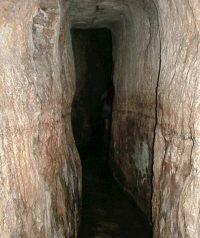
Shekhinah (שכינה - alternative transliterations Shekinah, Shechinah, Shekina, Shechina, Schechinah, sometimes spelled Shchinah in Judaism) is the English spelling of a feminine Hebrew language word that means the dwelling or settling, and is used to denote the dwelling or settling presence of God, especially in the Temple in Jerusalem. Shekhinah is the "gentle" or "feminine aspect" of the Divine.
Etymology
Shechinah is derived from the Hebrew verb 'sakan' or 'shachan'. In Biblical Hebrew the word means literally to settle, inhabit, or dwell, and is used frequently in the Hebrew Bible. (See e.g. Genesis 9:27, 14:13, Psalms 37:3, Jeremiah 33:16), as well as the weekly Shabbat blessing recited in the Temple in Jerusalem ("May He who causes His name to dwell [shochan] in this House, cause to dwell among you love and brotherliness, peace and friendship"). In Mishnaic Hebrew the word is often used to refer to bird's nesting and nests. ("Every bird nests [shechinot] with its kind, and man with its like, Talmud Baba Kammah 92b.) and can also mean "neighbor" ("If a neighbor and a scholar, the scholar is preferred" Talmud Ketubot 85b). The word "Shechinah" also means "royalty" or "royal residence" ( The Greek word 'skene' - dwelling - is thought to be derived from 'shekinah' and 'sakan'. The word for Tabernacle, mishcan, is a derivative of the same root and is also used in the sense of dwelling-place in the Bible, e.g. Psalm 132:5 ("Before I find a place for God, mishcanot (dwelling-places) for the Strong One of Israel.") Accordingly, in classic Jewish thought, the Shekhina refers to a dwelling or settling in a special sense, a dwelling or settling of divine presence, to the effect that, while in proximity to the Shekhinah, the connection to God is more readily perceivable.
The Shekinah is held by many to represent the feminine attributes of the presence of God (shekhinah being a feminine word in Hebrew), based especially on readings of the Talmud.
The Shekhinah is referred to as manifest in the Tabernacle and the Temple in Jerusalem throughout Rabbinic literature. It is also reported as being present in the acts of public prayer, ("Whenever ten are gathered for prayer, there the Shechinah rests" Talmud Sanhedrin 39a); righteous judgment ("when three sit as judges, the Shechinah is with them." Talmud Berachot 6a), and personal need ("The Shechinah dwells over the headside of the sick man's bed" Talmud Shabbat 12b; "Wheresoever they were exiled, the Shechinah went with them." Megillah 29a).
 The historicity of Jesus (i.e., his existence as an actual historical figure), is accepted as a theological axiom by three world religions, Christianity, Islam and the Bahá’í Faith, based on their respective scriptures.
The historicity of Jesus (i.e., his existence as an actual historical figure), is accepted as a theological axiom by three world religions, Christianity, Islam and the Bahá’í Faith, based on their respective scriptures.













 Isaac or Yitzchak (Hebrew: יִצְחָק "he will laugh") was the only son of Abraham and Sarah, and the father of Jacob and Esau as described in the Hebrew Bible. His story is told in the Book of Genesis. Isaac was the longest-lived of the patriarchs, and the only biblical patriarch whose name was not changed. Isaac was the only patriarch who did not leave Canaan, although he once tried to leave and God told him not to do so. Compared to other patriarchs in the Bible, his story is less colorful, relating few incidents of his life.
Isaac or Yitzchak (Hebrew: יִצְחָק "he will laugh") was the only son of Abraham and Sarah, and the father of Jacob and Esau as described in the Hebrew Bible. His story is told in the Book of Genesis. Isaac was the longest-lived of the patriarchs, and the only biblical patriarch whose name was not changed. Isaac was the only patriarch who did not leave Canaan, although he once tried to leave and God told him not to do so. Compared to other patriarchs in the Bible, his story is less colorful, relating few incidents of his life.







